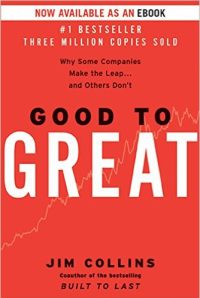I had read Good to Great: Why Some Companies Make the Leap … And Others Don’t by Jim Collins years ago but I decided to re-read it because for whatever reason when I read it the last time, I didn’t have any memorable pull quotes – I didn’t have anything specific I could say I got from it. That may seem like an odd reason to reread a book – and it is. I knew there was some wisdom here that I just couldn’t put my fingers on. I decided to apply my new approach to reading and researching to the book. (See my post “Research in the Age of Electrons“.)
One of the challenges with the Good to Great book – and I believe why I had trouble identifying specific call outs, is that it’s focused on large organizations. My organizations don’t classify as large. With only myself as an employee and with a handful of contractors – the kinds of pressures that large organizations face are just not the same ones that I face in my organizations. However, that being said many of my clients are large organizations and many of those large organizations are struggling with greatness.
The core of the book is looking for common characteristics of organizations that were able to sustain better than market performance (3x) for a long time (fifteen years). Along the way there were some pretty interesting observations including the fact that CEOs coming in from the outside were negatively correlated with greatness.
Perhaps what intrigued me the most during this rereading was the idea that motivation, alignment, and commitment seem to happen magically if you can determine the one central mission of the organization and get the organization started on that path. Ultimately the book calls the one thing the hedgehog concept, a simplification of what the leader or organization is passionate about, what they can be the best at the world at, and what drives the economic engine. The idea is that we’re all off chasing distractions and those distractions rob us of the power we need to be truly great.
I was struck by the ability for organizations to be able to focus on the key things and ignore the rest. Even in the description of the process Collins refers to “dogs that did not bark” which comes from a Sherlock Holmes story. However, it reminded me of Sources of Power by Gary Klein and more specifically about the idea that experts make decisions by seeing the critical elements and establishing expectancies. When those expectancies are violated they know they need to reevaluate.
I was also struck by the dichotomy that the book calls the Stockdale Paradox – “You must maintain unwavering faith that you can and will prevail in the end, regardless of the difficulties, AND at the same time have the discipline to confront the most brutal facts of your current reality, whatever they might be.” The knowledge that you’ll reach your goal – not on the timeline you want – and only after you face reality.
One of the key messages – and speaking as someone who continues to try to find the right people is very difficult – is getting the right people on the bus. That is, getting the right people onboard with the company – and then figuring out where the organization is going.
It didn’t escape me that much of what the book talks about is subtle. The difference between a vision and the singular focus of a hedgehog concept is hard to see. The difference between respectful disagreement and scientific inquiry compared to a more typical meeting is difficult to diagnose. The short of it is that you have to know what you’re looking for – and that can be tricky.
As I’m considering what friction exists for motivation, Good to Great offered some great insight for me, perhaps it can for you too.


No comment yet, add your voice below!